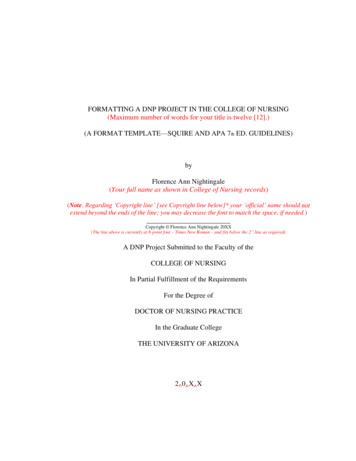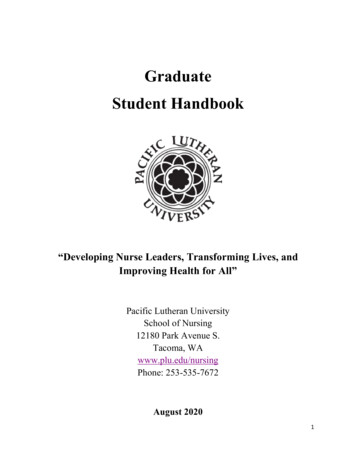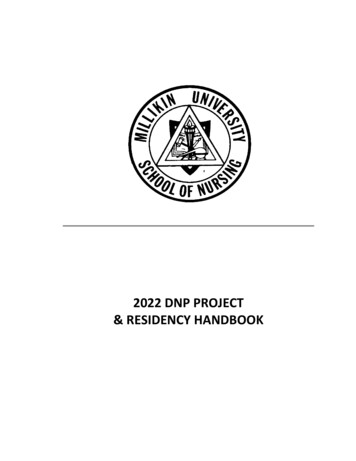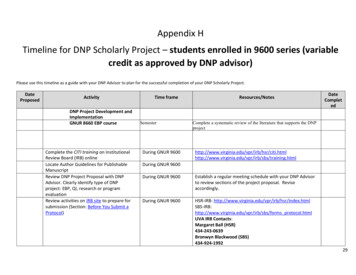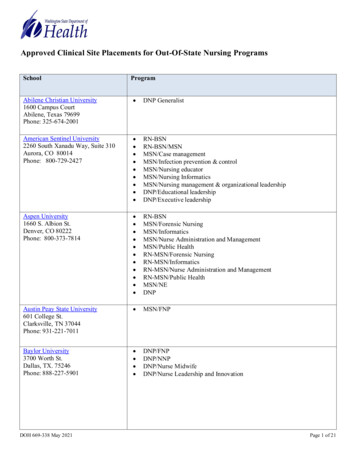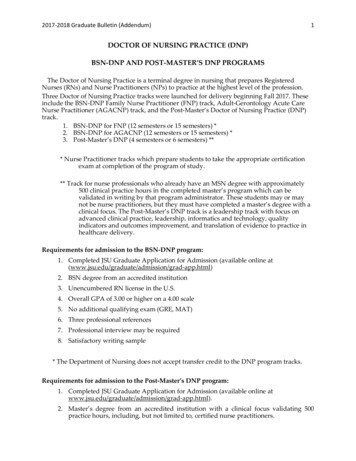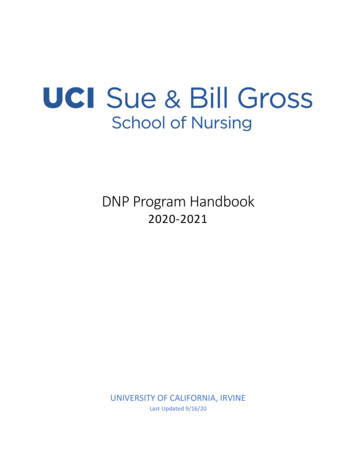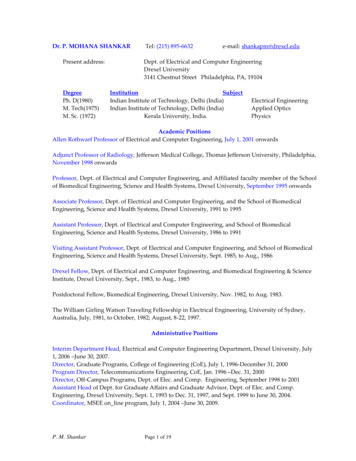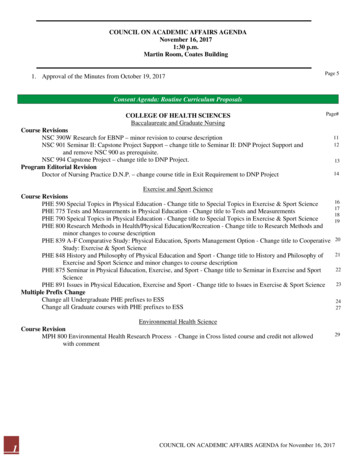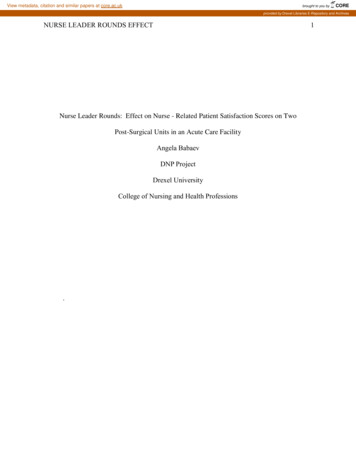
Transcription
View metadata, citation and similar papers at core.ac.ukbrought to you byCOREprovided by Drexel Libraries E-Repository and ArchivesNURSE LEADER ROUNDS EFFECT1Nurse Leader Rounds: Effect on Nurse - Related Patient Satisfaction Scores on TwoPost-Surgical Units in an Acute Care FacilityAngela BabaevDNP ProjectDrexel UniversityCollege of Nursing and Health Professions.
NURSE LEADER ROUNDS EFFECT2AcknowledgementsI would like to take a moment and acknowledge people who made this achievement possible.First and foremost, I would like wholeheartedly thank Dr. Ellen Giarelli for accepting to be thechair of my doctoral defense committee and by carefully, patiently, diligently with excellentmentorship and guidance qualities throughout this education lead me in my pursuit of DNP.Dr. Ellen Giarelli, my deepest gratitude to you for your knowledge, continues positive support,dedication, your kindness and intelligence. It meant the world to me.Dr. Joan Bloch thanks so much for being supportive and joining the committee to support me inthis process. I am very grateful to you for your immediate response, flexibility and support.Dr. Hardie, I have no words to describe my gratitude to you for your time and support. Thankyou for immediately accepting to help me. Your kindness and help in this endeavor will never beforgotten.I would like to thank my children for supporting me in my pursuit of the DNP. It would not havebeen possible without you in my life.
NURSE LEADER ROUNDS EFFECT3Table of ContentsAbstract .4Background and Significance 5Definition of Terms . . .7Literature Review .8Conceptual Framework 16Purpose . .17Methodology .19Procedure and Implementation .20Protection of Human Subjects . 21Data Collection and Data Management 24Results 26Discussion .29Study Limitations .32Clinical Relevance . 32Suggestions for Further Research/Clinical Application .33Conclusion .34References .36Table . .38Appendix A: Nurse Specific Items of the Patient Survey .39Appendix B: Nurse Leader Rounding Script . .40
NURSE LEADER ROUNDS EFFECT4AbstractBackground and Significance: The best possible inpatient experience is a priority for manyhospitals in today’s model of healthcare delivery. Achieving and sustaining measurable successis a key challenge. Nurse leader rounds (NLR) has been revealed to be an effective improvementstrategy in some hospitals. The purpose of this DNP project was to analyze the impact ofimplementing daily NLR on patient satisfaction (PS) scores in two postsurgical units at MountSinai Beth Israel (MSBI) hospital in New York.Methods: This study used descriptive comparison to analyze existing survey data before and afterNLR was implemented. The study took place in an academic, urban, tertiary care hospital in twopostsurgical units. Data were collected using the Hospital Consumer Assessment of HealthcareProviders and Systems (HCAHPS) survey reflecting questions to measure patient’s perceptionsof care, specifically, assessing the nurse related communication to examine if there was arelationship between NLR and PS scores.Results: Patient perception data summarized in this study suggested that the implementation ofNLR was associated with increased levels of patient satisfaction with communication (SC) withnurses following NLR in the inpatient setting on two post-surgical units. The results indicatedsignificant difference between the pre and post scores of SC in nurse related questions referringto communication (Appendix A).Conclusion: Effective implementation of NLR can improve patient perception of care.Improvements in nurse communication impacted PS. Areas for improvement were to focus onpatient self-management of care and medication education.Keywords: nurse leader rounds, patient satisfaction, nurse leader
NURSE LEADER ROUNDS EFFECT5Nurse Leader Rounds: Effect on Nurse - Related Patient Satisfaction Scores on TwoPost-Surgical Units in an Acute Care FacilityNurse leaders (NL) are faced with various challenges, one of which is to insure a safequality experience for hospitalized patients and their loved ones. Even though health care leadersrecognize the patient’s experience is their highest priority, many struggle to balance the factorsthat impact this experience while providing exceptional care. A high priority of healthcareadministrators is to ensure positive inpatient experiences. Nurse leaders are in a position to fosterchanges proactively necessary to impact patient experience. To assure consistency and quality inthe delivery of care, NLR was created which a systematic process that is recommended as a bestpractice according to Baker and McGowan (2010). Assessing patients daily, during morningrounds by a doctor or nurse, has been part of medical practice since its existence as a profession.During rounding, healthcare providers gather information while speaking to the patient directly.Registered nurses and or physicians assess the patient, develop a trusting relationship, listen towhat patients have to say about the care being provided, and are immediately available to addressany concerns raised by the patient by conveying all the necessary orders to anyone responsible tofollow up on addressing the patient’s needs. NLR works in a similar manner. This strategy allowsNL to connect to patients, reinforce care, verify nursing behaviors, gain real-time response,achieve instantaneous service recovery, recognize staff, follow up to assure all patients needs aremet, and develop a trusting relationship. NLR is a proactive approach to the delivery of care thatmay be one of the strategies to connect patient satisfaction, quality of care and healthcarereimbursement (Baker & McGowan, 2010).The new healthcare reform known as “Obama care” that was passed by Congress in 2010with the primary goal to provide quality care based on best practices and proven outcomes
NURSE LEADER ROUNDS EFFECT6(Centers for Medicare & Medicaid Services, 2014). The Center for Medicare and MedicaidServices (CMMS) is responsible for establishing and maintaining guidelines for hospitals toreceive governmental healthcare reimbursement (CMMS, 2014). The new reimbursement systemlinks healthcare compensation directly to quality care, and pay for performance, also called aValue Based Purchasing initiative. A standardized questionnaire named Hospital ConsumerAssessment Health Care Providers and Systems (HCAHPS) was created by CMMS to measureoutcomes and patients’ perception of care delivered the measurement of which is reflected inpatient satisfaction. This survey was implemented in 2006 and designed by the Agency forHealthcare Research and Quality (AHRQ) to query recently discharged hospital inpatients with27 essential questions divided into specific domains of care (communication and care fromnurses, response of hospital staff, medication management, pain management, dischargeinformation, transitions of care) (CMMS, 2014). This tool is believed to accurately assess theprimary drivers of adult inpatient satisfaction scores and is designed to provide a standard andobjective comparison of a hospital performance relative to other hospitals (Merlino, 2014). TheCMMS program rewards acute care hospitals with incentive payments based on the quality ofcare provided, how closely best clinical practices are followed, and how well hospitals enhanceinpatients experience (Merlino, 2014). Therefore, any effort to improve scores would bewelcomed by hospital administrators.A key challenge for hospitals is how to improve patient satisfaction by using HCAHPSquestions as a source of patient feedback and to use as a guide for NL to translate the content intoindividualized patient specific actionable items (i.e. cultural values, language, self-healthmanagement, health literacy) order to enhance the care delivered. NLR permits morepersonalized patient care plan and provides a thorough understanding of potential patient
NURSE LEADER ROUNDS EFFECTconcerns. One-to-one patient feedback during NLR allows for individual interaction and visualassessment of the patients’ perception of care, which can only increase the benefits of thepurpose for HCAHPS surveying. Accounting for patient preferences involves matching thequestions to the individual; which requires asking the right questions as part of a whole plan ofcare and the discharge planning process. The NL ability to bridge patient feedback into tacticalaction using NLR as an organizational strategy provides the capability to move an organizationforward from reactivity to proactivity (Studer, Robinson, & Cook, 2010).Regardless of the organization, all NLs promote and practice open, two-waycommunication among patients and providers to clarify treatment goals and design actions toaccomplish them. Additionally, the nurse leader/manager “is responsible for ensuring not onlypatient care is given but also it is given in the most effective and efficient manner possible”(Tappen, Weiss & Whitehead 2004, p. 6).The purpose of the study was to explore if there was an impact of NLR on patientsatisfaction. According to Tappen, Weiss and Whitehead a manager or nurse leader is defined asa person capable to stimulate employee “creativity, consistent excellent productivity, andmaximum potential contribution toward continuous improvement of process, product, andservice” (2004, p. 6). NLs may include unit nurse managers, supervisors, department directors,nurse education managers, or clinical nurse managers of a unit or division within a health careorganization.Definition of TermsNurse leader (NL). A NL is defined as a person able to stimulate employee “creativity,consistent excellent productivity, and maximum potential contribution toward continuousimprovement of process, product, and service” (Tappen et al., 2004, p. 6). NL include unit nurse7
NURSE LEADER ROUNDS EFFECT8managers, or clinical nurse managers of a unit or division within health care organization (Studeret al., 2010)Nurse leader rounds (NLR). NLR is a process that allows nurse leaders to connect topatients, reinforce care, verify nursing behaviors, gain real-time response, achieve instantaneousservice recovery, recognize staff, follow up to assure all patients needs are met, and develop atrusting relationship. (Baker & McGowan, 2010).Effective nursing rounds (ENR). ENR is defined as the ability of a leader to motivatestaff in accordance with the mission and goals to proactively ensure the delivery of safe, highquality care and identify improvement opportunities (Studer et al., 2010).Patient satisfaction. PS is defined as the patient’s perception of care reflected by patientsatisfaction scores collected using HCAHPS and is directly related to the quality of nursing carepatients receive (Studer et al., 2010).Rounds. Rounds are defined as the systematic visits to establish communication, todiscuss medication management and plan of care. They involve direct observation, assessmentand evaluation of patient, staff, unit functioning, clinical environment and global view of patientstatus (Studer et al., 2010).Literature ReviewFor the purpose of this project relevant electronic databases such as: Cumulative Index toNursing and Allied Health Literature (CINAHL), Medline, and The Cochrane Library weresearched using following keywords: nursing, nurse leader, rounding, nurse leader rounds, andpatient satisfaction while working closely with a Drexel librarian and Mount Sinai Beth Israellibrary database to find research articles in the past five years. The search found 25 articles. Aftercareful review ten articles were included in the review that included words: nurse leader, leader
NURSE LEADER ROUNDS EFFECT9rounding, rounding. The review summarized the studies on the major variables of: CMMSfinancial demands, types of rounds, nurse leader rounds/rounding (NLR), patient satisfaction(PS), and the relationship between NLR and patient satisfaction.CMMS financial demandsAs CMMS attempted to meet financial demands in healthcare, new laws were passed thatbased Medicare payments, in part, on quality. To quantify patient experiences standardizedgovernmental healthcare survey/report card HCAHPS was created as part of Value BasedPurchasing program under which beginning fiscal year 2013, inpatient hospitals saw a 1%reduction, which will incrementally increase to 2% by fiscal year 2017 in reimbursements fromMedicare (CMMS, 2014). It has become essential to improve patient satisfaction scores ifhospitals want to receive reimbursements and in some instances to survive staying open. Patientperception of care reflected by patient satisfaction scores, collected using HCAHPS, is directlyrelated to the quality of nursing care patients receive.RoundsHealthcare literature has information about different types of rounds with patients. NLRwith patients have been described as a strategy associated with improvement of ratings frompatients regarding their inpatient care. Rounds involve direct observation, assessment andevaluation of patient, staff, unit functioning, clinical environment and global view of patientstatus. The effectiveness of this type of nursing rounds is in ability of leader to move staff,mission, and goals towards same destination to proactively ensure the delivery of safe, highquality care and identify improvement opportunities. As the ACA transformed healthcarereimbursement methods to the hospitals at its foundation, NLR have been identified as one of thestrategies impacting patient satisfaction scores.
NURSE LEADER ROUNDS EFFECT10Day-to-day NLR allows for proactive assessment of quality of nursing care on units froma patients’ perspective and provides immediate feedback to coach individual nurses. During NLRthe leader clarifies questions patients may have, assesses knowledge gaps about nursing carereceived, provides discharge instructions or medication management, and develops a personaltouch using individualized approach to meet patient needs. Literature contains information andresearch on different types of rounds with patients. Even though many support NLR and havequoted its value, very few have documented the impact of this practice on nurse related patientsatisfaction scores. Research by Thompson (2008) summarized the feedback collected from 20prominent nurse leaders. The American healthcare emphasis is no longer on the course of howthe care is delivered, but rather the results of the care. Specifically, new emphasis is on federalreporting of patient satisfaction scores with the services provided. According to Thompson(2008), producing quality outcomes, high patient satisfaction, and real measurements of both arevital themes in healthcare organization and management leadership teams. For NL quality andsafety outcomes signifies accountability for managing and leading the staff responsible forproviding quality and safety patient care connected to the financial burden of the hospital.NLR Effect on Patients’ SatisfactionSetia and Meade (2009) addressed how a combination of implementing NLR anddischarge telephone calls simultaneously produced positive patient satisfaction outcomes andpatient quality of care. According to the authors, with implementation of both tactics (dischargecalls and NLR) in a Hackensack University Medical Center in New Jersey, there was asignificant increase in patient satisfaction and quality of care, versus the individual effect ofeither one of tactics reflected in the HCAHPS survey data. About 50% of the patients thatanswered “yes” to receiving a discharge call and “yes” to a visit by a NL has shown level of
NURSE LEADER ROUNDS EFFECT11satisfaction greater than 99th percentile in national database for several nurse related patientsatisfaction domains such as communication/responsiveness of the nurse, preparation ofdischarge instructions, likelihood to recommend, and patient perception of their overall care(Setia & Meade, 2009).Additionally, according to Baker and McGowan (2010), consistent use of rounding as afoundational leadership tactic delivers quality service, and increases clinical and operationalresults in many emergency departments. In this study the authors discussed three types ofrounding implemented in the emergency department: a) leader rounding on staff; b) leaderrounding on patients; and 3) leader rounding in the reception area. The authors emphasized thatleader rounding was the single best way to raise not only patient satisfaction scores but alsoincrease nurse satisfaction, nurse loyalty, and attract new high-performing nurses. As Baker andMcGowan (2010) indicated, leader rounding improved nurse-related patient experienceoutcomes such as: established nurse-patient communication, plan of care, medicationmanagement, and discharge planning. It is the most consistent way of asking questions, to obtainactionable information about what is working well, and to identify areas for improvement. Thegoal specifically for leader rounding in the reception area was to reduce patients that left withoutbeing triaged in emergency department. According to Baker and McGowan study, leaderrounding on patients in the reception area led to catching three extra patients each day beforethey left emergency department without treatment and added an additional 219,000 to 328,500 in annual revenue for the hospital (Baker et al., 2010).In 2011, Blakley, Kroth, and Gregson (2011), described the close relationship between aconsistent rounding program addressing all patient needs and overall patient satisfaction scores.The researchers, using case study method, showed how overall patient satisfaction scores
NURSE LEADER ROUNDS EFFECT12steadily increased in conjunction of the rounding program from 3.50 (n 200) in the first quarterto 3.60 (n 101) of the 3rd quarter at the medical surgical unit of the West Valley Medical Centerin Caldwell Idaho. The researchers did not report any p values to demonstrate the statisticalsignificance of this study (Blakley et al., 2011).Hutchings, Ward, and Bloodworth (2013) suggested that managing patient expectationsduring the interactive rounding by nurses and nursing leadership established a foundation forchange at Nottingham University Hospital in the United Kingdom (UK). Hutchings andcolleagues presented a model that combined three types of rounding (hourly nurse rounding;leadership rounding and senior leadership rounding) with coaching of the staff during the project.They also timed the nurses’ responses to patient calls. The program resulted in significantfavorable outcomes. There was a 32% average reduction in the patient’s use of call lights, moreinteractions with patients allowing frequent assessment of skin integrity, mobility of patients,nutrition, and leaders getting real time feedback from patients, and nursing staff improvedmorale. The results led to expanding this project across 79 wards over a 14-month period(Hutchings et al., 2013).Morton (2014) examined patient experiences through NLR implemented across a largehealthcare system. The study was done at a large health care system named Providence Healthand Services that serves patients across five states Alaska, California, Montana, Oregon, andWashington. The system employed over 64,000 people, included 32 hospitals and otherambulatory settings. The study was implemented in inpatient settings and emergencydepartments. All nurse leaders were trained. Each hospital added a question to the survey, “Did anurse leader visit you during your stay?” The authors reported statistically significant changes (p 0.01) in all aspects of patient care in global and individual domain areas. NLR was associated
NURSE LEADER ROUNDS EFFECT13with increased levels of patient satisfaction. According to these researchers, inpatients whoreported receiving a NL round during their stay rate both global and all individual aspects ofhospital stay more positively than those patients who did not report receiving a visit from nurseleader. The rating improved from being below the national rate from 2008-2011 (beforesystematic implementation of NLR) to exceeding the national rate of change followingimplementation of this practice. The experience and the results summarized by the researchers ofthis study suggested that reliable implementation of NLR represents one strategy that can be usedto improve patient satisfaction (Morton et al., 2014).Hospital Consumer Assessments of Health Care Providers and Systems (HCAHPS)Keith et al., (2015) examined the effect of a leaders’ program to improve patientsatisfaction scores on the HCAHPS. The results of the implemented program revealed increasedpatient satisfaction scores. As a result of this study, one key element identified by the leaders wasto have accountability in order to sustain a successful standard of quality care.Winter and Tjiong (2015) examined the question, “Does purposeful nurse leader roundingmake a difference?” In this study the goal was to round on patients twice a week for the purposeof asking exact questions related to patient experience, nursing care and customer service. Thisquality improvement study was conducted in a 95 bed acute care hospital in North Texas. Threeunits were involved: intensive-care unit ICU (10 beds); progressive care unit PCU (16 beds);acute care unit ACU (32 beds) with 90% occupancy rate giving 52 total number of beds with theaverage daily patient census (estimated number of rounds completed 2,506). Researchers of thisstudy did not find a correlation between leader rounding questions and HCAHPS surveyquestions. Although this study did not show the expected results, the hospital believed leaderrounding had benefits and intended to continue the practice. Authors explained the unexpected
NURSE LEADER ROUNDS EFFECT14findings as possibly due to sample selection and response bias of the data set (Winter & Tjiong,2015).NLR Effect on Nurse-Related Patient Satisfaction ScoresA study done by Volland and Fryda (2015) addressed effectiveness of NLR on dischargeplanning of patients. Successful discharge planning across settings is a direct responsibility ofnurses which required multiple levels in coordination of care. The starting point was the NLRgiving an ability to bridge patient feedback into tactical action and to develop a discharge plan ofcare in an individualized manner. Tailoring to patient and family preferences, understandingpatient’s health self-management, assessing the knowledge on medication purpose, developingan action plan in coordination with primary care physician were the areas to address as adischarge plan of care was proactively developed in conjunction with NLR. According toVolland and Fryda (2015), involving patients and families in their discharge plan was the bestpractice for medication management for patients (Volland & Fryda, 2015).Results in the literature support the claim that there is a positive correlation between NLRand patient satisfaction scores. The literature has repeatedly shown that NLR provides a valuableopportunity to prevent adverse events, improve quality of care, evaluate patient education efforts,and identify trends that require improvements, determine patient compliance with dischargeinstructions, and assess overall perception of care or hospital performance. The connectionallows NL to link with patients every day, which provides an opportunity for pre-emptivedelivery of care. However, other elements such as communicating with nurses, understandingmedications, understanding what should occur at discharge as well as post discharge are alsoessential in improving quality, safety and patient perception of care. Improving patientsatisfaction scores is not easy but focusing on nurse-related patient satisfaction items will add to
NURSE LEADER ROUNDS EFFECT15a growing body of specific evidence on the value of NLR in contemporary health care. Thisstudy allowed to better understand the effect of NLR to nurse-sensitive items on patientsatisfaction surveys.Smith (2015) described the nursing leader’s main goals: a) “to provide exemplaryleadership” and b) “to support and impact the change in healthcare.” Smith questioned andexplored how nurse leaders can set the stage to engage, improve, impact and ultimately influencewhile coordinating quality and safe care. The author also emphasized that nursing leadership isan indicator and predictor of organizational outcomes (Smith, 2015).Nurse Leader at Mount Sinai Beth IsraelAs part of Mount Sinai Health System (MSHS) is an integrated health care systemencompassing the Icahn School of Medicine at Mount Sinai and seven hospital campuses in theNew York metropolitan area. MSHS was created from combination of The Mount Sinai MedicalCenter and Continuum Health Partners in 2013. Mount Sinai Beth Israel (MSBI) is an 856 bedteaching hospital founded in 1889 serves the lower east side residential area of Manhattan. Witha significant Medicare/Medicaid patient population, MSBI implemented the NLR process withthe goal to improve patient experience and HCAHPS scores after having low scores for severalyears. NLR were designed to decrease variation in care and thus better impact inpatientexperience. Determining the immediate need was a goal based on the daily involvement of NL inassessing, coaching, coordinating, holding all staff accountable to assure consistent service. Theobjective of providing safe and quality service to every patient, every time and utilizing allnursing, and ancillary services was prioritized to influence patient satisfaction scores.Even though there are number of studies supporting the benefits of NLR, as well as theimproved patient satisfaction scores associated with NLR, it was important to evaluate if indeed
NURSE LEADER ROUNDS EFFECT16it does improve patient satisfaction once implemented at MSBI. Patients’ feedback gatheredduring NLR was the best way to know if the patient’s personal needs were met according toStuder et al., (2010). Hospital performance and quality of care were publicly reportable by theHCAHPS survey which is standardized and used by many hospitals for appraisal and comparisonagainst each other concerning patient experience (Centers for Medicare & Medicaid Services(2014). There are many studies published on the benefits of NLR, however, few exist on therelationship of NLR to nurse-related patient satisfaction scores and how NLR can improvepatient satisfaction with nursing care specifically.This study focused on the relationship between NLR and nurse related patient satisfactionin two post-surgical units in order to understand if there was a relationship between thesevariables and the magnitude of the relationship.Conceptual FrameworkEvidence based leadership (EBL) (Studer et al., 2010) is a framework that allowshospitals or any healthcare facility to create a system of aligned goals and absolute accountabilitythat ensures execution every time. This leadership framework was introduced by Studer,Robinson & Cook (2010) and refers to the importance of reducing variances in leadership skillsand processes to produce predictable positive outcomes. EBL, as a foundation, allows hospitalsto develop strategies that most impact their desired outcomes in consistent manner. The EBLframework consists of three components: aligned goals, aligned behaviors, and alignedprocesses. According to Studer et al., (2010) healthcare facilities that were able to incorporateand emphasize the above mentioned components were proven to get results (Studer, Robinson &Cook, 2010).Purpose
NURSE LEADER ROUNDS EFFECT17The purpose of the project was to examine the association of NLR with nurse-relatedmeasures of patient satisfaction on two postsurgical units in an acute care facility. This projecthad four specific aims:(1) To examine if there was a difference in the percentile scores of patient satisfaction withcommunication (SC) with nurses following NLR implementation,(2) To examine if there was a difference in the percentile scores of patient satisfaction withmedication management (SMM) (i.e., communication about new medicines, side effects)following NLR implementation,(3) To examine if there was a difference in the percentile score of patient satisfaction withdischarge information (SDI) (information about help, signs and symptoms to look for) followingNLR implementation, and(4) To identify ways to improve and expand NLR in the hospital using analyses from nursespecific items (aims 1 to 3).VariablesThe variables of interest are defined below.Nurse leader rounding (NLR). As an independent variable, NLR was defined as asystematic process recommended as a best leadership practice to assure consistency according toBaker et al., (2010) and was measured by quality of care delivered and patient’s perceptions ofcare. During the NLR, the nurse leader was learning the experience of patients on her or his unit.While rounding, the nurse leader was establishing relationship with patients, and gatheringinformation by direct visual and clinical observation during assessment and evaluation. The NLRwas done daily except the weekends using a scripted nurse leader tool or questionnaire. NLRstrategy was measured by the HCAHPS survey question “did the nurse manager visit you during
NURSE LEADER ROUNDS EFFECT18your stay?” The collected response was “yes” or “no”. The percent of patients who reportdefinitely “yes” was reported as a best result.Satisfaction with communication (SC). This dependent variable was defined as thepatient’s satisfaction with inpatient experie
DNP Project Drexel University College of Nursing and Health Professions . View metadata, citation and similar papers at core.ac.uk brought to you by CORE provided by Drexel Libraries E-Repository and Archives. NURSE LEADER ROUNDS EFFECT 2 Acknowledgements


